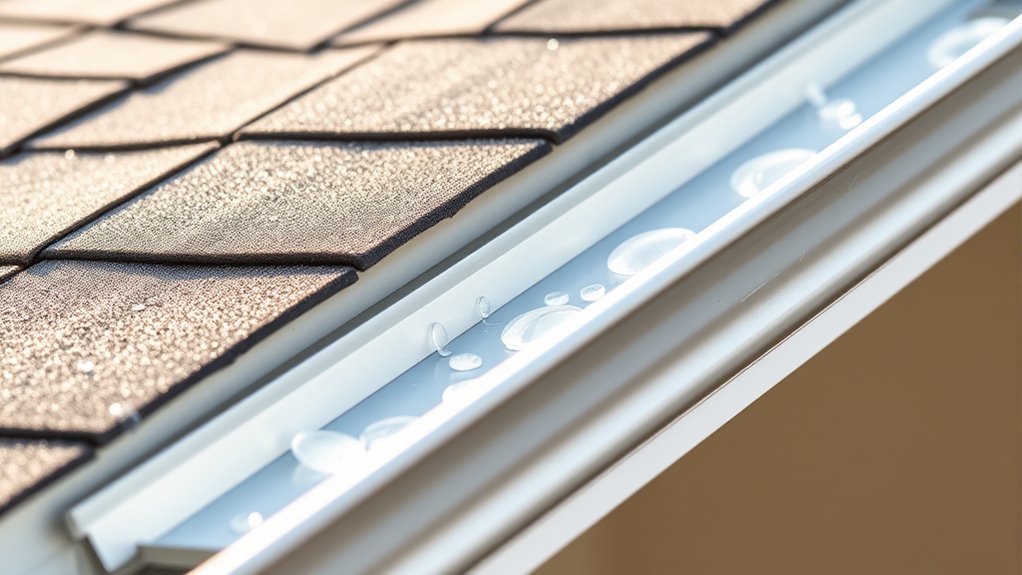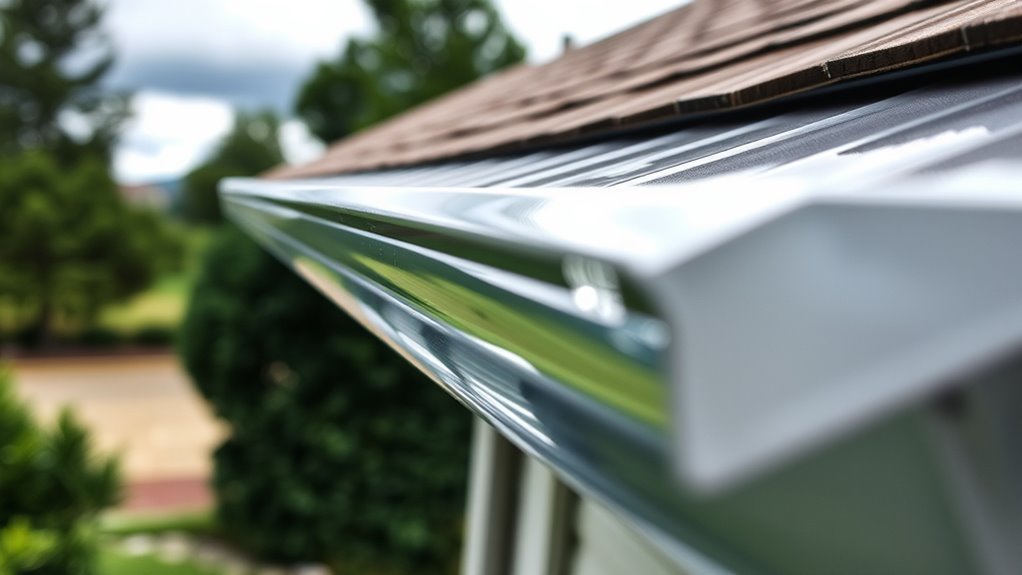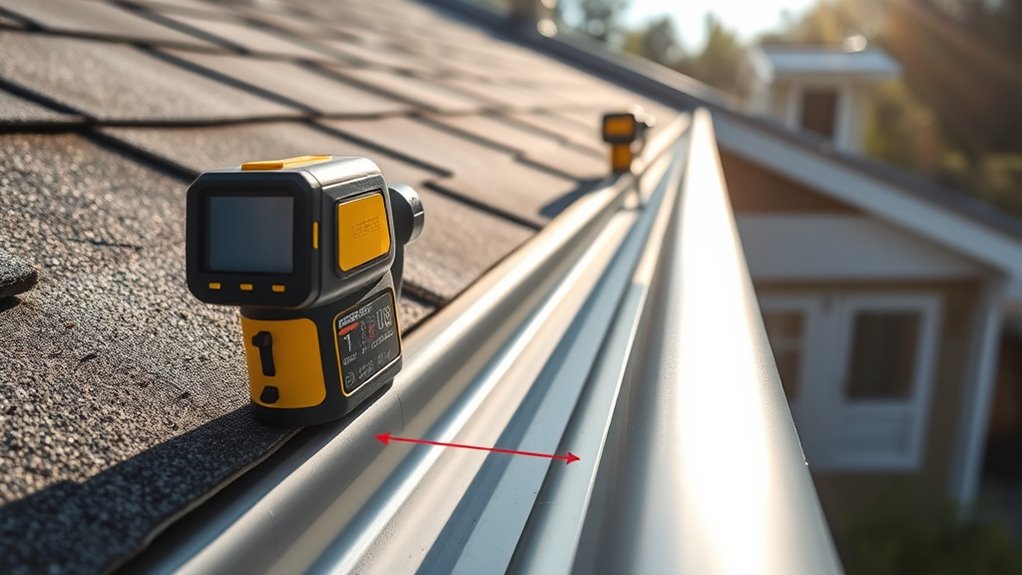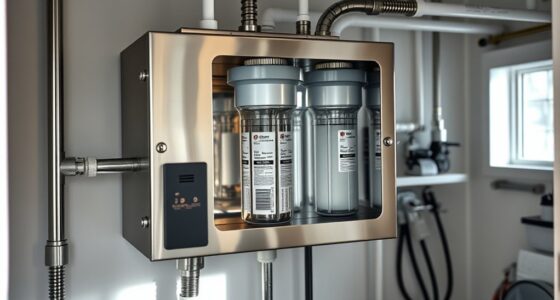To guarantee your gutters handle heavy rain effectively, you need to choose the right size and slope. Proper sizing prevents overflow and protects your foundation and landscaping, while the correct slope ensures water flows smoothly to the downspouts without pooling or overshoot. Factors like roof size, local rainfall, and debris influence your choices. Making these adjustments correctly keeps your system efficient and long-lasting. Keep exploring to learn precise tips for ideal gutter performance.
Key Takeaways
- Proper gutter sizing prevents overflow, protects your foundation, landscaping, and maintains home integrity.
- Measure roof area and analyze rainfall data to determine appropriate gutter capacity and size.
- Maintain a uniform slope of about 1/4 inch per 10 feet to ensure effective water flow and prevent pooling.
- Choose durable materials like aluminum or copper for weather resistance and longevity.
- Regular cleaning and correct installation practices are essential to avoid clogs, leaks, and system damage.
Understanding the Importance of Proper Gutter Sizing

Have you ever wondered why some gutters seem overwhelmed during heavy rains while others handle the flow effortlessly? Proper gutter sizing is key. The gutter material, like aluminum or vinyl, affects durability but also influences capacity—thicker materials can often support larger sizes. Aesthetic design matters too; seamless or decorative gutters can enhance your home’s appearance while ensuring enough space for heavy rainfall. If gutters are too narrow, water will overflow, risking damage to your foundation and landscaping. Conversely, oversized gutters might look awkward and cost more without added benefit. Choosing the right size guarantees your gutters manage rain efficiently, protecting your home, and maintaining its visual appeal. Proper sizing is an investment in both function and style, keeping rainwater where it belongs—away from your house. Additionally, gutter slope plays a crucial role in facilitating proper drainage and preventing water pooling.
Factors Influencing Gutter Capacity

Several factors come into play when determining a gutter’s capacity to handle rainwater effectively. Leaf debris can clog gutters, reducing their ability to carry water and increasing overflow risk. Regular cleaning helps maintain capacity, especially during heavy rain. Gutter material also influences capacity; for instance, aluminum gutters are lightweight and resistant to rust, while steel gutters are stronger but may corrode over time. The thickness and design of the material affect how much water the gutter can manage before overflowing. Additionally, the presence of debris and the overall slope can impact flow efficiency. Choosing the right gutter material and maintaining clear gutters ensures ideal capacity, preventing water damage to your home during storms.
Calculating the Correct Gutter Width and Flow Rate

To choose the right gutter width, you need to know your roof’s size and how much rain your area gets. Measure your roof’s surface area and find local rainfall data to determine your gutter’s capacity needs. Once you have these figures, you can select the appropriate gutter size and flow rate for effective drainage. Additionally, understanding local building codes and permits can help ensure your gutter installation complies with safety standards.
Determining Roof Area and Rainfall
How do you guarantee your gutters can handle the rainwater runoff from your roof? Start by accurately determining your roof area and understanding typical rainfall in your region. Measure the square footage of your roof, considering all slopes and angles. This helps estimate the volume of water that’ll flow into your gutters during storms. When selecting gutter material, choose durable options like aluminum or copper that can withstand weather conditions. Proper installation techniques are vital to make certain of efficient drainage; secure brackets firmly and set the right slope for water to flow smoothly. By combining precise roof area calculations with appropriate gutter material and correct installation, you ensure your gutters won’t overflow or clog during heavy rains.
Calculating Gutter Capacity Needs
Ensuring your gutters can handle heavy rain requires calculating the appropriate gutter width and flow rate. Start by considering the gutter material, as some materials like aluminum or copper are more durable but may influence size choices. You need to determine the peak flow rate based on your roof’s size and local rainfall intensity, factoring in seasonal considerations such as winter snow melt or heavy summer storms. A wider gutter can handle larger volumes, especially if your area experiences frequent or intense rainfall. Calculating the correct flow rate ensures water moves efficiently without overflow or damage. Proper sizing minimizes clogging and prolongs gutter lifespan, helping you protect your home year-round. Additionally, understanding gutter sizing principles can further optimize your rainwater management system. Accurate calculations are essential for effective rainwater management.
Determining the Optimal Slope for Effective Drainage

Finding the right slope for your rain gutters is essential to guarantee proper drainage and prevent water buildup. Typically, a slope of 1/4 inch per 10 feet works well, but it depends on your gutter material and installation guidelines. Metal gutters usually require a slightly steeper slope, while vinyl gutters need a gentle tilt. To determine the optimal slope, measure from the high point near the roof’s edge to the low end at the downspout. Ensure the slope is consistent along the length, avoiding dips or flat sections that can cause clogs. Here’s a quick guide:
| Gutter Material | Recommended Slope |
|---|---|
| Metal | Slightly steeper (1/4 inch per 8 ft) |
| Vinyl | Gentle (1/4 inch per 10 ft) |
| Aluminum | Standard (1/4 inch per 10 ft) |
Additionally, understanding the proper slope can help maximize drainage efficiency and reduce maintenance issues.
Common Mistakes in Gutter Slope Installation

One common mistake is setting incorrect pitch angles, which can cause water to pool or overshoot the drain. Ignoring proper drainage design also leads to ineffective water flow and potential damage. Making these errors can markedly reduce your gutter system’s performance and longevity. Additionally, neglecting to consider the coverage area can result in choosing an undersized gutter that cannot handle heavy rainfall, further compromising the system’s effectiveness.
Incorrect Pitch Angles
Incorrect pitch angles are a common mistake that can substantially impact your gutter system’s effectiveness. When the slope is too shallow, water won’t flow properly, leading to gutter misalignment and standing water. Conversely, an overly steep pitch causes water to rush too fast, risking damage or leaks. Proper pitch ensures efficient drainage and prevents clogs. Use the table below to understand the ideal slope:
| Issue | Result |
|---|---|
| Incorrect pitch angles | Water stalls or flows too rapidly |
| Gutter misalignment | Water overshoots or leaks at joints |
Adjusting the pitch to the correct angle maintains gutter integrity. Always check your measurements carefully, as improper slope affects overall performance and longevity. Ensuring the proper gutter slope can help prevent these issues from occurring.
Ignoring Proper Drainage
Have you overlooked how crucial proper drainage is when installing your gutter slope? Ignoring drainage can lead to water pooling, causing damage to your landscape design and risking foundation issues. Poorly designed slopes with unsuitable gutter materials can create backups, overflow, and attract pests. When you neglect proper drainage, you’re risking:
- Water damage that destroys your landscape’s beauty
- Foundation problems that threaten your home’s stability
- Clogged gutters that become a nightmare to clean
Choosing the right gutter materials and ensuring correct slope are essential. Proper drainage isn’t just about avoiding inconvenience; it’s about protecting your property’s integrity and aesthetic appeal. Don’t overlook this critical step—your landscape design and home depend on it.
Tools and Techniques for Accurate Slope Measurement

Accurately measuring the slope of your rain gutters is essential to guarantee proper water drainage and prevent leaks. To do this, you’ll need a level or a digital inclinometer, which provides precise readings. First, identify the gutter material, since different materials may require specific tools or techniques for measurement. Place the level along the gutter’s length, ensuring it’s firmly supported. Check the slope at multiple points to confirm consistency. If you’re choosing color options for your gutters, keep in mind that darker shades can sometimes absorb heat, affecting material expansion and slope. Using these tools and techniques, you’ll ensure your gutters are properly aligned, optimizing water flow and reducing future maintenance needs. Additionally, understanding AI in Business can help in analyzing data for optimal gutter placement and slope accuracy.
Maintenance Tips to Preserve Gutter Performance

Regular maintenance is key to keeping your gutters functioning properly and preventing costly repairs. Regularly inspect your gutters for debris buildup, especially after storms, to guarantee water flows smoothly. Clean out leaves and twigs to prevent clogs that can cause water damage. Choose gutter material that resists corrosion and weathering, like aluminum or vinyl, for longevity. Consider color options that complement your home’s exterior, making maintenance less of a chore.
Regular gutter checks prevent clogs and costly water damage.
- Feel confident knowing your gutters protect your home from water damage.
- Enjoy peace of mind with gutters that look great year-round.
- Save money by preventing costly repairs caused by neglect.
Frequently Asked Questions
How Often Should Gutters Be Inspected for Proper Slope and Capacity?
You should inspect your gutters at least twice a year, especially during spring and fall, to guarantee proper slope and capacity. Regular gutter cleaning helps prevent clogs, but seasonal inspections catch issues early. Look for standing water, sagging sections, or debris buildup. Maintaining the correct slope allows water to flow freely, reducing the risk of damage. Consistent inspections keep your gutters functioning properly and extend their lifespan.
What Are Signs of Improper Gutter Sizing or Slope Issues?
Ever wonder if your gutters are working properly? Signs of improper sizing or slope include excessive gutter debris and leaf accumulation, which indicate water isn’t flowing freely. You might also notice pooling water or overflowing during rain, revealing inadequate capacity or poor slope. These issues can cause damage to your home, so regularly check for clogging and make sure your gutters are correctly pitched to keep water moving smoothly away from your house.
Can Gutter Size Affect Drainage During Heavy Storms?
Yes, gutter size can influence drainage during heavy storms. If your gutters are too small for the volume of water, especially with a steep roof pitch, they may overflow or clog easily. Choosing the right gutter material and size guarantees proper flow. Larger gutters handle more water, preventing backups, while the right slope directs runoff efficiently, reducing the risk of water damage during intense rainfall.
What Materials Are Best for Maintaining Proper Gutter Slope?
Think of your gutters as a slide; the right material keeps the slope smooth and steady. Aluminum is a top choice because it’s lightweight, durable, and easy to adapt for proper slope. Vinyl also works well, especially in colder climates. When you select materials, focus on their ability to withstand weather and allow precise slope adjustment. Proper material selection ensures rainwater flows seamlessly, protecting your home from water damage.
How Does Climate Influence Gutter Size and Slope Requirements?
Climate impact plays a big role in your gutter customization. In heavy rainfall areas, you’ll need larger gutters to handle more water, and a steeper slope helps runoff flow efficiently. Conversely, in drier climates, smaller gutters with gentler slopes may suffice. By adjusting size and slope to your climate, you guarantee your gutters work effectively year-round, preventing water damage and reducing maintenance needs.
Conclusion
By paying attention to gutter sizing and slope, you’ll guarantee your gutters work like a well-oiled machine, efficiently directing water away from your home. Proper measurements and adjustments keep clogs and leaks at bay, saving you time and money. Think of your gutters as the veins of your roof—if they’re properly sized and sloped, they’ll drain smoothly like a mountain stream. Stay diligent with maintenance, and your gutters will serve you reliably for years to come.









